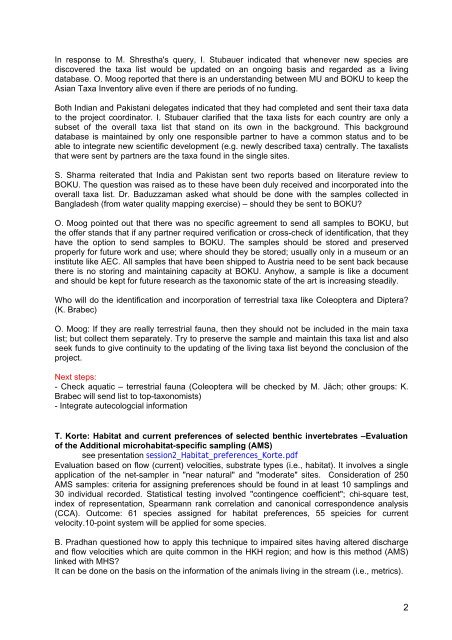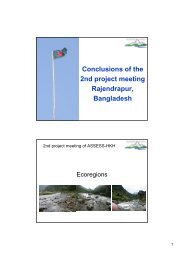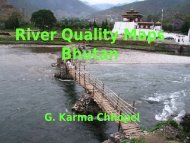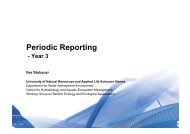2007 - ASSESS-HKH
2007 - ASSESS-HKH
2007 - ASSESS-HKH
You also want an ePaper? Increase the reach of your titles
YUMPU automatically turns print PDFs into web optimized ePapers that Google loves.
In response to M. Shrestha's query, I. Stubauer indicated that whenever new species are<br />
discovered the taxa list would be updated on an ongoing basis and regarded as a living<br />
database. O. Moog reported that there is an understanding between MU and BOKU to keep the<br />
Asian Taxa Inventory alive even if there are periods of no funding.<br />
Both Indian and Pakistani delegates indicated that they had completed and sent their taxa data<br />
to the project coordinator. I. Stubauer clarified that the taxa lists for each country are only a<br />
subset of the overall taxa list that stand on its own in the background. This background<br />
database is maintained by only one responsible partner to have a common status and to be<br />
able to integrate new scientific development (e.g. newly described taxa) centrally. The taxalists<br />
that were sent by partners are the taxa found in the single sites.<br />
S. Sharma reiterated that India and Pakistan sent two reports based on literature review to<br />
BOKU. The question was raised as to these have been duly received and incorporated into the<br />
overall taxa list. Dr. Baduzzaman asked what should be done with the samples collected in<br />
Bangladesh (from water quality mapping exercise) – should they be sent to BOKU<br />
O. Moog pointed out that there was no specific agreement to send all samples to BOKU, but<br />
the offer stands that if any partner required verification or cross-check of identification, that they<br />
have the option to send samples to BOKU. The samples should be stored and preserved<br />
properly for future work and use; where should they be stored; usually only in a museum or an<br />
institute like AEC. All samples that have been shipped to Austria need to be sent back because<br />
there is no storing and maintaining capacity at BOKU. Anyhow, a sample is like a document<br />
and should be kept for future research as the taxonomic state of the art is increasing steadily.<br />
Who will do the identification and incorporation of terrestrial taxa like Coleoptera and Diptera<br />
(K. Brabec)<br />
O. Moog: If they are really terrestrial fauna, then they should not be included in the main taxa<br />
list; but collect them separately. Try to preserve the sample and maintain this taxa list and also<br />
seek funds to give continuity to the updating of the living taxa list beyond the conclusion of the<br />
project.<br />
Next steps:<br />
- Check aquatic – terrestrial fauna (Coleoptera will be checked by M. Jäch; other groups: K.<br />
Brabec will send list to top-taxonomists)<br />
- Integrate autecologcial information<br />
T. Korte: Habitat and current preferences of selected benthic invertebrates –Evaluation<br />
of the Additional microhabitat-specific sampling (AMS)<br />
see presentation session2_Habitat_preferences_Korte.pdf<br />
Evaluation based on flow (current) velocities, substrate types (i.e., habitat). It involves a single<br />
application of the net-sampler in "near natural" and "moderate" sites. Consideration of 250<br />
AMS samples: criteria for assigning preferences should be found in at least 10 samplings and<br />
30 individual recorded. Statistical testing involved "contingence coefficient"; chi-square test,<br />
index of representation, Spearmann rank correlation and canonical correspondence analysis<br />
(CCA). Outcome: 61 species assigned for habitat preferences, 55 speicies for current<br />
velocity.10-point system will be applied for some species.<br />
B. Pradhan questioned how to apply this technique to impaired sites having altered discharge<br />
and flow velocities which are quite common in the <strong>HKH</strong> region; and how is this method (AMS)<br />
linked with MHS<br />
It can be done on the basis on the information of the animals living in the stream (i.e., metrics).<br />
2






